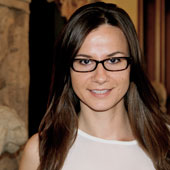I became interested in the 2014 SAH study tour, “Croatia: At the Crossroads of Time and Space” because it offered the opportunity to learn more about the particular geographical, political, and cultural events that have the power to shape a region in an immediate and direct way. These elements were particularly interesting to me as I work to complete a dissertation on cultural exchanges and society in Roman Dacia (present day Romania), an area that was connected to the western world in antiquity by a combination of land and water routes. By studying these long term cross-cultural and cross-temporal interactions at work in the Adriatic I wanted to better understand how particular nodes, especially those located along strategic points such as trade routes and waterways developed into dynamic zones of interaction while also retaining their own character and personality. During our tour, I developed a better sense of the many layers that have been established over time and whose presences can still be detected in both the urban and rural fabric, beginning in antiquity and continuing to the present day.
I came to appreciate and understand how diverse landscapes are constantly changing, seemingly shaped by an infinite number of hands. Through analysis of a variety of built environments, I had the chance to understand the potential for architecture to interact with nature, either by resisting it or by integrating with it. During the tour, I considered the ways in which spaces and structures appear to be built with a special kind of knowledge – as if the architects sense that that their works will face innumerous impediments to their continuity (such as earthquakes, fires, and war to name the most common). However, it is in light of these constant and many threats that architecture also triumphs because it manages to retain those faint traces of past lives and a potential for reinvention and reuse that can last over the course of centuries.
For me this experience will remain an inspiration to visit Croatia again, and hopefully revisit old friends and sites but also experience new ones. Among these one might mention for example the sensory-oriented creation by Nikola Bašić, known as “Sea Organ” (2005) in Zadar, a design that brings together a built structure with the natural environment, harnessing the power of both in order to create musical notes using the wind and sea waves.
I would like to thank first the Society of Architectural Historians who prepared this tour, the Scott Opler Endowment for New Scholars for funding this experience, to my department at UCSB who further supported this endeavor, and to our tireless tour leaders Boris Srdar and Ken Oshima for leading us through these many rich landscapes. To Franica Srdar and all the tour participants who in ten short days were no longer simply travel companions but friends, and who enriched the tour in so many ways with their perspectives and by adding that certain special touch of humor and lightheartedness that is fundamental to any travel excursion. I am also grateful to the crew of the Corinthian and the many pilots who guaranteed or safe arrival to the many ports along the way. Finally, to the people of Bosnia and Herzegovina, Montenegro, Croatia and the city of Venice who kindly welcomed us and shared their neighborhoods, their homes and their stories and who extended their hospitality to us so that we might grow in our knowledge and experience, a heartfelt thank you to all.
 Ana M. Mitrovici, Ph.D. Candidate, University of California, Santa Barbara
Ana M. Mitrovici, Ph.D. Candidate, University of California, Santa Barbara
Ana Mitrovici is a Ph.D. candidate in the department of History of Art and Architecture at the University of California, Santa Barbara. She received her B.A. in Classical Studies and French from Concordia College, MN, and a master’s degree from UCSB. Her dissertation examines cultural exchange, healing, and the interaction of the natural and built environment in the Roman province of Dacia. She is currently the recipient of the University of California Humanities Research Institute Andrew Vincent White and Florence Wales White Fellowship for 2014-2015, funding that supports research in the humanities and medicine.